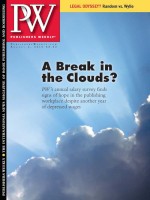Six-month reports from four publicly traded companies show that the publishing industry is performing very much like the general economy, recovering from the recession in a bumpy fashion. Even within the same company, different units are reporting different results. With state budgets under severe pressure, sales in the McGraw-Hill school group were down 7.3% in the first half of the year, while the higher education/professional/international group had a 4.6% increase, benefiting from high college enrollments and increased digital sales.
The same trends were evident at Pearson's North American Education group. Although Pearson did not break out results for the school and higher education divisions, it was clear that the growth for the combined group was led by higher education. Both McGraw-Hill and Pearson said they remain optimistic about prospects for higher education, and while the elhi market may grow, it will expand at a slower rate than earlier forecasts. MH lowered its elhi growth forecast for the full year to 4%–6% from 6%–7%.
Pearson's other publishing division, Penguin, had a good first half with solid gains in sales and profits. In the U.S., Penguin exceeded expectations, CEO David Shanks said, driven by good performances across all areas. The company had a record 150 New York Times bestsellers, while also posting gains in backlist sales. The children's division benefited from John Grisham's first young adult title, and e-book sales tripled and represented about 8% of sales. Sales of digital audio downloads doubled, and a reorganization of Penguin's international sales efforts resulted in good gains. Penguin Group chairman John Makinson said that while comparisons will be tougher in the second half of 2010, he was optimistic about the outlook for the full year.
Sales at Harlequin fell in the first half of the year, due entirely to the strength of the Canadian dollar. Harlequin has one of publishing's most ambitious digital publishing programs, and gains in that format in North America helped to offset a decline in print sales through its North American Retail group. Harlequin sees similar trends for the remainder of the year with digital sales growing, offsetting declines in North America Retail, while the strong Canadian dollar dampens the overall results.
Courier Corp.'s nine-month results reflected an improvement in its printing business but continued softness in publishing. The company's manufacturing operations were led by demand for Courier's four-color services, and the company had gains in all three markets—trade, education, and religion. But with the general economy still uncertain, Courier is not looking for a significant improvement in sales in the near term. Its publishing division continues to be hurt by the slumping housing market, which has cut demand for titles from Creative Homeowner, which, along with Dover Publications, had a loss in the first nine months of the year. Results at REA were up.
Six-Month Scorecard ($ in millions)
| Sales | profit | |||||
|---|---|---|---|---|---|---|
| 2009 | 2010 | % Change | 2009 | 2010 | % Change | |
| Pearson | ||||||
| North American Education | £943.0 | £1,017.0 | 4.8% | £12.0 | £51.0 | 325.0% |
| Penguin | 452.0 | 493.0 | 7.0 | 21.0 | 44.0 | 89.5 |
| McGraw-Hill Education | $867.2 | $882.2 | 1.7% | ($55.5) | ($10.2) | |
| School Group | 461.2 | 436.5 | -7.3 | NA | NA | |
| Higher Education/ Professional/International | 406.6 | 445.8 | 4.6 | NA | NA | |
| Harlequin | C$248.6 | C$230.6 | -4.2 | C$40.3 | C$43.1 | 8.9% |
| Courier Corp.* | ||||||
| Publishing | $34.9 | $34.1 | -2.9% | (3.1) | (0.9) | |
| Manufacturing | 153.5 | 161.6 | 4.3 | 6.7 | 12.2 | 80.0 |



 Volume 257
Issue 30
08/02/2010
Volume 257
Issue 30
08/02/2010





